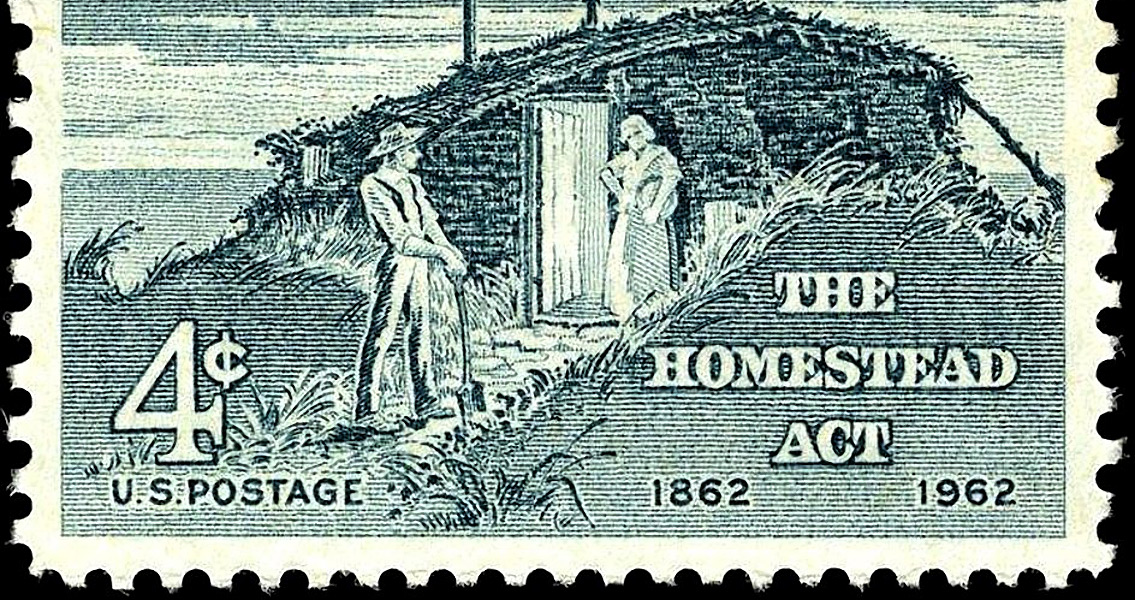<![CDATA[On 20th May, 1862, Abraham Lincoln signed the Homestead Act into law. A hugely important piece of legislation, the Homestead Act played a key role in opening the western frontier of the United States to settlement but had a devastating effect on the remaining Native American populations in North America. The Act set out to open up government owned land to small family farmers (homesteaders). Any head of a family could apply to the government for up to 160 acres of land to cultivate and attempt to live the life of a farmer on for five years. The individual had to be at least 21 years old and was obliged to build a house on the land, significantly, the scheme was open to freed slaves. After five years of farmer live the homesteader could apply for a 'proved certificate' which confirmed that his homestead had been successful. Once he had received this $18 certificate the farmer would receive a deed to the land. Although many homesteaders gave up on frontier life before completing the five years, meaning their land reverted back to the government, the scheme was successful. By the time of its repeal by Congress in 1976, some four million people had been awarded land under the Homestead Act, amounting to 10% of the total land area of the United States being given out. Estimates suggest that around 93 million people living in America today are in fact descendants of a homesteader family. There had been objection to the Act prior to Lincoln signing it into law, and it was the context of the American Civil War which facilitated its eventual implementation. Similar acts had been proposed in 1852, 1854 and 1859, but were defeated by a powerful lobby from the southern slave holding states who feared that the new western territories would ultimately enter the Union as free states, giving greater influence to the northern Abolition Movement. Northern industrialists also opposed the idea of government sponsored western expansion, fearing it would draw their work force west, thus empowering workers who remained in the northern cities by reducing labour competition. It was only when the Southern states seceded from the union that real impetus was given to pushing through the Homestead Act. A major consequence of the Act, and one which is often overlooked, is its impact on Native American tribes who had long inhabited the lands of the western frontier. Policies of Native American relocation had existed long before the implementation of the Homestead Act; most notably, President Andrew Jackson had focused on forcibly moving the already decimated Native American population to lands west of the Mississippi River. The Homestead Act however, encouraged settlers from the United States to move onto this land west of the Mississippi which had supposedly been reserved for Native Americans. The Homestead Act saw the Federal government force Native Americans off their land, and ultimately triggered the final phases of the 'Indian Wars', the conflict between white colonists and Native Americans over North America. The famous Battle of the Little Bighorn, for example, was caused by a drive to force Native Americans off of lands in Montana which had been found to contain gold. Following the western migration triggered by the United States' settlement of the western frontier, Native Americans increasingly found themselves confined to living in small reservations whose poor conditions often led to sickness, despondency and death. In 1887, the Dawes General Allotment Act was passed which can be seen as a version of the Homestead Act applied to Native Americans. It aimed to distribute reservation land among individual Native Americans in a manner similar to the Homestead Acts, attempting to encourage them to live their lives in the image of the frontier farmers. Native Americans who took land from the act became US citizens, and the Dawes Act seems, at least in intention, to have been motivated by genuine, if misguided, concern for the welfare of Native Americans. Ultimately, the Dawes Act had unanticipated consequences, stemming from the fact that Native Americans were forced to abandon their nomadic and tribal way of life, before being absorbed into an unfamiliar system of fixed agriculture and private land ownership. Many were unable to adjust to the new farming lifestyle, while others were swindled out of their property. Conditions on reservations continued to worsen, and Native American culture and ways of life were further eroded. The Homestead Act was a key moment in establishing the modern United States, encouraging property ownership and the settling of the Western Frontier, but it also contributed to the increasing decline of Native American populations. ]]>
The Homestead Act
